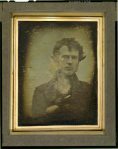

Models for Grant Woods’ ‘American Gothic’ (1930) posed with painting. Via Twenty Two Words.

Daguerreotype of Robert Cornelius, likely the first photographic self-portrait ever taken, c 1839. Via American Library of Congress.
These three intriguing photographs have no real relationship with one another, except that each image reveals a little bit of the hidden history of art. Read on for more about these remarkable images.
Picasso wearing a ‘cow head mask’, 1949
The first image is a light-hearted 1949 photograph of Pablo Picasso on a French beach, wearing what is described as a cow’s head mask.
However, I believe that the image is mislabeled and that he is actually modelling a bull’s head, a reference to his Spanish heritage and the country’s stereotypical association with bullfighting.
This does little to mollify the absurdity of the scene, but at least it makes better sense that he would use an animal which he references throughout his artistic practice.
(See, for example, his  Bull’s Head (1942); Bull lithograph series (1945); Guernica (1937); Bull’s Head, Turned to the Right (1948), etc.). This photograph presents Picasso as an extension of the art he makes, and, I think, lives up to our expectation of the eccentric artist.
Bull’s Head (1942); Bull lithograph series (1945); Guernica (1937); Bull’s Head, Turned to the Right (1948), etc.). This photograph presents Picasso as an extension of the art he makes, and, I think, lives up to our expectation of the eccentric artist.
Interestingly, Picasso was photographed again wearing a bull mask in a lesser-known photograph by Edward Quinn in 1960, perhaps suggesting that it was his idea and not the photographers’.
 Models from Grant Wood’s American Gothic (1930) with painting
Models from Grant Wood’s American Gothic (1930) with painting
Could these two people ever have known how famous their faces would become when they agreed to pose for Grant Wood?
Although the couple in the iconic painting are often mistaken as husband and wife, Wood intended them to be read as a father with his spinster daughter. He chose his sister Nan and his dentist (Dr. Byron McKeeby) to model, because he thought they looked like the kind of people who ought to live in the Gothic Revival cottage he depicts in the background (a real house which he came across in Eldon, Iowa).
What makes this photograph so striking, I think, lies in the fact that the painting has become so familiar that it almost seems more ‘real’ than the humans it depicts: my eye sees their real faces as deviating from the faces in the painting, rather than vice versa. (But don’t you think Wood has captured the expression of the dentist perfectly?)
 Robert Cornelius’ 1839 daguerreotype self-portrait
Robert Cornelius’ 1839 daguerreotype self-portrait
As anyone who has ever had a Facebook account will tell you, selfies are everywhere. And this humble daguerreotype taken by Robert Cornelius started this grand and slightly self-indulgent tradition.
Cornelius was a photography pioneer and lamp manufacturer who opened the second photography studio in America. As far as anyone knows, this was the first photographic self-portrait ever taken.
I find it surprising that it is not better known. That handsome and youthful face, perfectly tousled hair, fashionably popped collar and cool expression…this guy was the pioneer of perfect profile pics. Shouldn’t he be worshiped by hipsters? After all, Cornelius was taking photographs of himself ‘way before it got, like, so mainstream’.
// Picasso photo from Life Magazine Archives, via Retronaut; second Picasso photograph by Edward Quinn, ca 1960, (via Live Auctioneers, from “Picasso at Work” book). American Gothic models via Twenty Two Words. Robert Cornelius self-portrait via American Library of Congress.
**UPDATE 28/12/2012: Retronaut seems to have deleted the original post featuring Picasso on the beach wearing a mask in 1949, but you can also see some of these images here, at Rotating Corpse.

Reblogged this on Mark Solock Blog.
Robert Cornelius is definitely Mr Darcy in disguise. He has all the qualities I imagine Darcy to have had.
Look at that broodtasticness.
Reblogged this on Éjaculat de mépris.
I love that couple from American Gothic. How perfect. The man looks JUST like his image.
How interesting. Like!! ;)